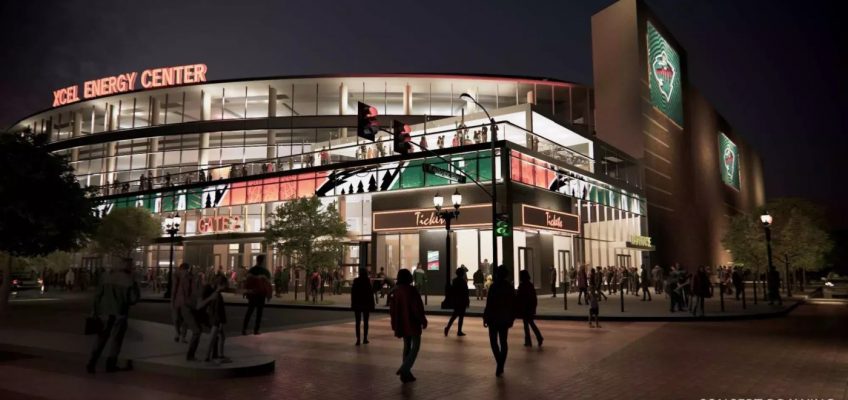St. Paul Mayor Melvin Carter and Craig Leipold, owner of the Minnesota Wild, again made their pitch to state lawmakers for nearly $400 million in state appropriation bonds to fund a makeover of the Xcel Energy Center and the city’s RiverCentre convention center.
They found a more receptive audience in a key Senate panel Tuesday than they did last week with a committee composed of House lawmakers.
They also found a sponsor. State Sen. Clare Oumou Verbeten, DFL-St. Paul, has signed on as an author of the bill, which is still being composed and has yet to be formally introduced.
St. Paul Mayor Melvin Carter answers questions about the Xcel Energy Center during a Minnesota Senate Capital Investment Committee hearing in the Senate Building in St. Paul on Tuesday, March. 25, 2025. Joining Mayor Carter is Minnesota Wild Owner Craig Leipold. The city of St. Paul and Minnesota Wild are funds to renovate the Xcel Energy Center. The request is for the state to pay for half of the projected $769 million cost. (John Autey / Pioneer Press)
State senators from both parties talked up the importance of having the city-owned X — and the Wild in particular — anchor a downtown that has lost workers, businesses and vitality since the onset of the pandemic and remote work.
State Sen. Karin Housley, R-Stillwater, agreed that downtown St. Paul had become a more desolate and sometimes scarier place in recent years, and she noted the positive impact the Nashville Predators — Leipold’s former National Hockey League team — have had on boosting their downtown after its dog years.
A year-round destination
The mayor reiterated claims that a $769 million renovation of the 25-year-old arena and convention center complex — which already draw some 2 million visitors annually — could boost downtown spending by another $110 million each year. Calling the design of the X outdated, Carter talked up the importance of creating a year-round destination, with cafes, pubs or other exterior, public-facing attractions that would draw interest even when the Wild are not playing.
“Most people come in and out of there and don’t realize this whole huge place, this professional sports arena, has one escalator to get people in and out,” said Carter, addressing reporters after his presentation to the Senate Capital Investment committee. “From a safety perspective, from an ingress and egress perspective, from an accessibility perspective … this arena really is archaic in its design.”
The city has released renderings and other project details on its website at stpaul.gov/xcel-arena-complex-renovation.
Still, the prospect of a $385 million ask from appropriations bonds is no small request given a state budget forecast that predicts deficit spending by the year 2028-2029.
Members of the House Capital Investment Committee appeared more skeptical last week, when state Rep. Maria Perez-Vega, a DFLer who represents downtown, listed a string of human service and infrastructure needs in her district and criticized Carter and Leipold for not first sharing with her the specifics of their request.
Lawmakers have said the appropriations bonds could be paid back in 20 years, adding some $33 million annually to the debt service paid through the state general fund, though Verbeten said her bill would instead call for a 30-year payback window.
“We’re fortunate we don’t have to tear down the arena and start over and rebuild what we have inside,” said Leipold, addressing lawmakers. “If we were going to start over, it would be about $1.1 billion.”
A rendition of the proposed renovation of St. Paul’s Xcel Energy Center. (Courtesy of the City of St. Paul)
Other requests for appropriation bond dollars
The arena complex isn’t the only project seeking state backing through appropriation bonds.
Michael Vekich, chair of the Minnesota Sports Facilities Authority, told lawmakers Tuesday that he would seek $30 million in state funding toward $85 million in security improvements around U.S. Bank Stadium in downtown Minneapolis, including bollards, anti-climb fencing and crash-rated fencing up to standards recommended but not required by the U.S. Department of Homeland Security.
Vekich said the project is “focusing on the hardening of the perimeter,” he said. “U.S. Bank Stadium is nine years old and the facility is in overall great shape.”
State Sen. Scott Dibble, DFL-Minneapolis, said while he had not voted for the stadium bill a decade ago, “we do have an obligation to keep this a world-class facility, and “it does make sense for the state to participate.”
Lawmakers noted that a Taylor Swift concert across two nights last June resulted in record hotel occupancy and hefty spending in downtown Minneapolis.
Why appropriation bonds?
The Senate Committee on Capital Investment on Tuesday received a presentation from Senate counsel Stephanie James outlining key differences between appropriation bonds and general obligations bonds, which are used more commonly to fund public projects. Among the differences, appropriation bonds can be used more flexibly than the latter, can be spent on privately-owned projects that carry a public purpose, and require a simple majority of lawmakers for approval instead of a three-fifths supermajority vote.
They’re paid back through annual appropriations that must be reauthorized by the state Legislature, making them riskier investments for bond holders, and therefore carry a higher interest rate. Appropriations bonds helped pay for the Minnesota Vikings stadium in downtown Minneapolis in 2014, the Lewis and Clark regional water system project near the intersection of Minnesota, Iowa and South Dakota in 2016, and environmental clean-up at a series of sites in 2021.
St. Paul Mayor Melvin Carter, left, talks with state Sen. Clare Oumou Verbeten, DFL-St. Paul, following a Minnesota Senate Capital Investment Committee hearing in the Senate Building in St. Paul on Tuesday, March. 25, 2025. The city of St. Paul and Minnesota Wild are funds to renovate the Xcel Energy Center. The request is for the state to pay for half of the projected $769 million cost. (John Autey / Pioneer Press)
Sports stadiums aren’t the only tools that city officials are looking to as they hope to revive two struggling urban downtowns.
Gov. Tim Walz announced Tuesday that as of June 1, he would require state employees back to downtown offices at least half-time. Carter noted that City Hall office workers will return to their cubicles three days per week as of April 1.
Related Articles
Contenders or pretenders? Wild may find out this week
In a late game, the Wild pounced on Seattle early
Slumping Wild still looking for that ‘next man up’ amid current storm
Wild can’t match Blues’ desperation, as offense struggles again
Vinnie Hinostroza’s 400th game comes as he finds another playoff race




